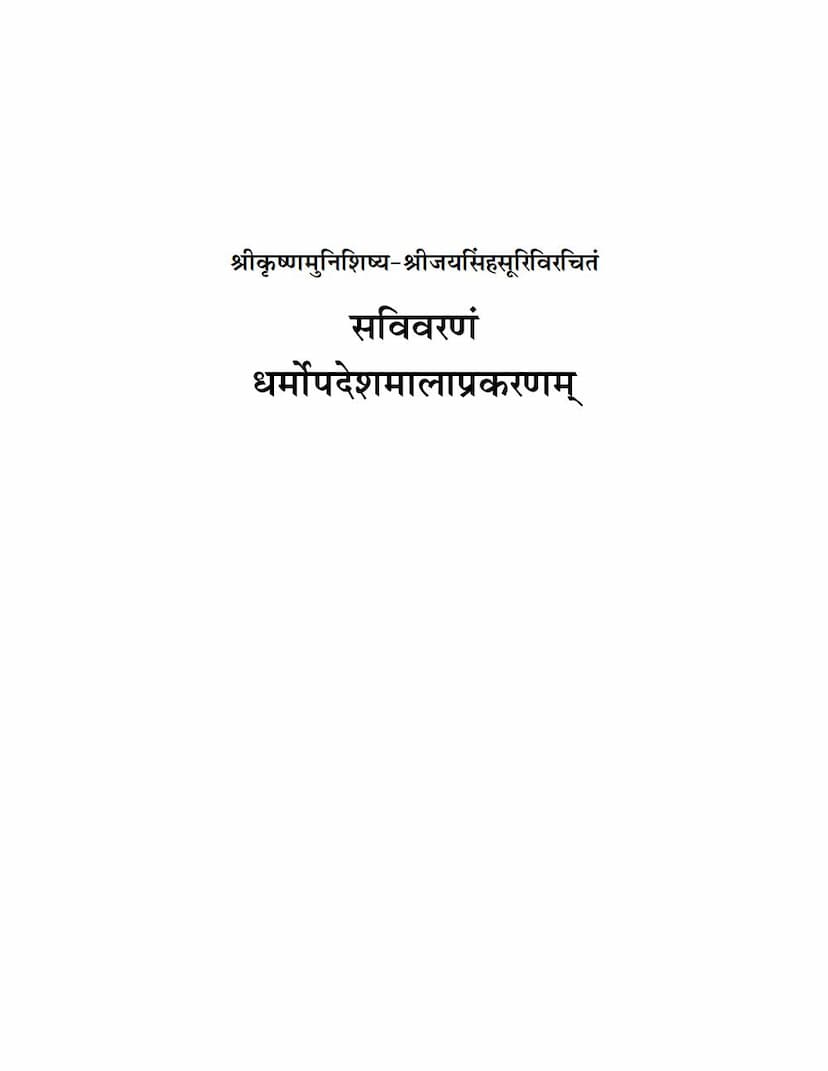Dharmopadeshmala Prakaranam
Added to library: September 1, 2025

Summary
Summary of "Dharmopadeshmala prakaranam" by Jaysinhsuri and Chandanbalashree
This Jain text, "Dharmopadeshmala prakaranam" (धर्मोपदेशमालाप्रकरणम्), is a collection of moral and religious discourses compiled and commented upon by esteemed Jain Acharyas. The work, authored by Jaysinhsuri (जयसिंहसूरि) and with a new edition inspired by Acharya Vijayramchandrasoorishwarji and compiled by Sadhvi Chandanbalashree, serves as a significant guide for the Jain monastic and lay community.
Key aspects and content of the text, based on the provided pages:
-
Authorship and Lineage: The primary author is Shree Jaysinhsuri (श्री जयसिंहसूरि), a disciple of Shree Krishnasyamuni (श्रीकृष्णमुनि). The commentary (विवरण) is attributed to the venerable Acharya Jaykeerti (जयकीर्तिसूरि). The new edition is credited to Sadhvi Chandanbalashree (साध्वी चंदनबालाश्री), a disciple of Acharya Bhagwant Shrimad Vijayramchandrasoorishwarji.
-
Purpose and Audience: The book is intended for the entire fourfold Jain community (साधु, साध्वी, श्रावक, श्राविका - monks, nuns, laymen, and laywomen) to encourage regular study and contemplation of religious principles. It is considered a foundational text for understanding core Jain teachings.
-
Structure and Content:
- The text is primarily in Prakrit (प्राकृतभाषामय), with a detailed commentary.
- It is structured as a "mala" or garland of discourses, likely containing stories and teachings that illustrate various virtues and ethical principles. The title "Dharmopadeshmala" itself suggests a collection of teachings arranged like a garland.
- The author mentions that the original work contains 98 Gathas (verses), with some additional verses in later commentaries that are considered interpolations.
- The text is noted to be an imitation or adaptation of Dharmadas Gani's (धर्मदासगणी) "Upadeshimala" (उपदेशमाला), which is considered older and more extensive. Jaysinhsuri's work, while following a similar style, is described as more concise and suggestive, focusing on providing a list of exemplary narratives (कथाओ की नामावलि) to illustrate specific teachings.
- The introductory materials highlight the comprehensive nature of the text, covering various aspects of Jain philosophy, ethics, and conduct, including:
- Virtues: Knowledge (ज्ञान), meditation (ध्यान), penance (तप), self-restraint (संयम), forgiveness (क्षमा), compassion (दया), wisdom (विवेक), empathy (अनुकम्पा), non-possession (अपरिग्रह), detachment (अनासक्ति), etc.
- Narratives (Kathas): The text is rich with stories that serve as practical illustrations of these virtues. These stories span various themes, including the lives of great souls, kings, ministers, virtuous women, and even parables that convey profound spiritual lessons.
- Historical and Cultural Insights: The text offers glimpses into ancient Indian society, geography, customs, and philosophical traditions, mentioning various regions, cities, and even different philosophical schools.
- Linguistic Value: Being in Prakrit, it is valuable for scholars of Prakrit language and literature, showcasing its grammar, vocabulary, and stylistic nuances, often compared to the prose of Sanskrit works like Bana's Kadambari.
-
Historical Context: The original work by Jaysinhsuri is dated to around 915 AD (वि.सं. ९१५). The first edition of this commentary was published in 1949 (वि.सं. २००५) by the Singhi Jain Shastrapith, Bharatiya Vidya Bhavan, Mumbai. The new edition was published in 2010 (वि.सं. २०६६) by Bhadrakar Prakashan, Ahmedabad.
-
Significance and Appreciation: The text is lauded for its didactic style, its adherence to Jain principles, and its ability to inspire the Jain community. The commentary is particularly noted for its depth and clarity, making the original teachings accessible. The new edition is a testament to the ongoing effort to preserve and propagate this valuable heritage of Jain literature.
In essence, "Dharmopadeshmala prakaranam" is a multifaceted work that combines didactic narratives, moral exhortations, and scholarly commentary, aiming to guide its readers toward spiritual upliftment and righteous living according to Jain principles. It reflects the rich tradition of Jain literature that emphasizes practical application of spiritual knowledge through relatable stories.